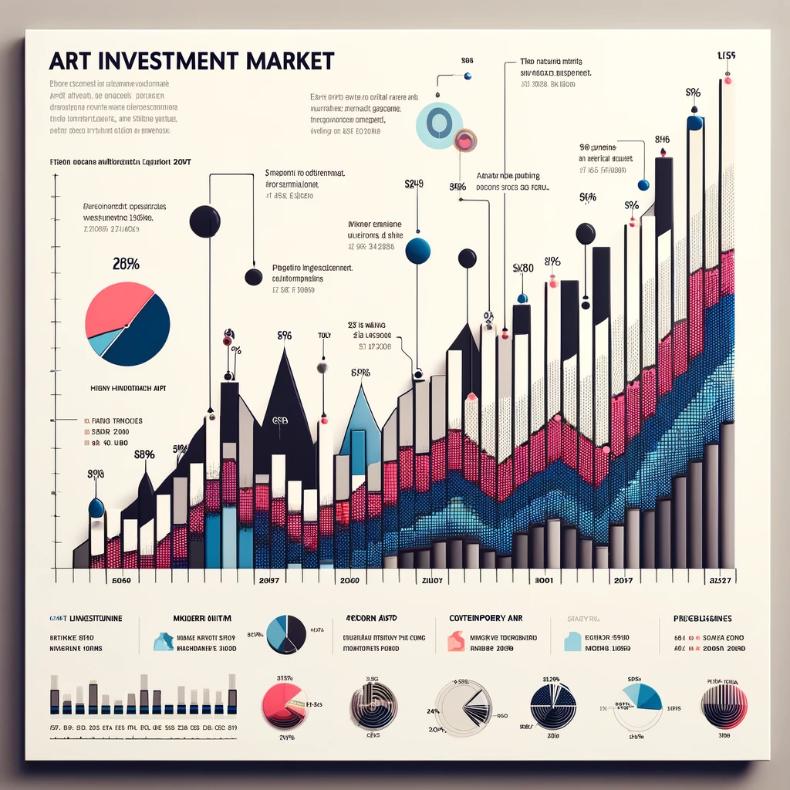Art Investment Strategy (Glossary Entry)
An art investment strategy is a financial plan designed to guide purchases of art with the intention of earning returns on the capital invested, much like traditional asset classes. Unlike more liquid investments such as stocks or bonds, investing in art incorporates aesthetic appreciation with economic benefit, often incorporating elements of personal passion and market knowledge. This strategy leverages the understanding that art can appreciate in valueIn color theory, value refers to the lightness or darkness of a color. This concept is crucial for artists and designers because it helps create depth, contrast, and visual interest in their work. Value is one of the three properties of color, alongside hue and saturation. Defining Value Value indicates how light or dark a color appears. It ranges from More over time, offering potential financial gains alongside cultural enrichment.
Understanding the Market
A fundamental aspect of any art investment strategy is a thorough understanding of both the primary and secondary art markets. The primary market consists of works sold directly by artists or their primary representatives, typically galleries, and often includes newly created works. The secondary market deals with works that have been previously owned, typically sold through auction houses, dealers, or private sales. Prices in the secondary market can be significantly higher, especially for works by recognized artists whose demand drives up valueIn color theory, value refers to the lightness or darkness of a color. This concept is crucial for artists and designers because it helps create depth, contrast, and visual interest in their work. Value is one of the three properties of color, alongside hue and saturation. Defining Value Value indicates how light or dark a color appears. It ranges from More.

Key Components of Art Investment
- Diversification: Just like with traditional investments, diversification is vital. Investors often spread their capital across various styles, periods, artists, and mediums to mitigate risk.
- Research: Effective art investment requires rigorous research to identify potential valueIn color theory, value refers to the lightness or darkness of a color. This concept is crucial for artists and designers because it helps create depth, contrast, and visual interest in their work. Value is one of the three properties of color, alongside hue and saturation. Defining Value Value indicates how light or dark a color appears. It ranges from More increases. This includes studying artist careers, historical price data, and market trends.
- Advisory Services: Many investors rely on art investment analysts or consultants to navigate the complexities of the art market. These professionals provide insights into when to buy or sell, forecast potential market shifts, and offer art investment advice on portfolio management.
- Art as an Investment: Beyond physical artwork, today’s investors also look to digital forms such as NFTs. Investing in art today includes both tangible paintings and sculptures as well as digital assets that are secured and traded on blockchain platforms, expanding traditional boundaries of art collecting.
Benefits of Art Investment
Investing in art provides a unique combination of emotional and financial benefits. It allows investors to own tangible, aesthetic pieces that can be enjoyed visually while potentially increasing in monetary valueIn color theory, value refers to the lightness or darkness of a color. This concept is crucial for artists and designers because it helps create depth, contrast, and visual interest in their work. Value is one of the three properties of color, alongside hue and saturation. Defining Value Value indicates how light or dark a color appears. It ranges from More. Art can act as a hedge against inflation and market volatility since its valueIn color theory, value refers to the lightness or darkness of a color. This concept is crucial for artists and designers because it helps create depth, contrast, and visual interest in their work. Value is one of the three properties of color, alongside hue and saturation. Defining Value Value indicates how light or dark a color appears. It ranges from More does not correlate directly with traditional financial markets. Additionally, the art market often provides opportunities for substantial returns through strategic acquisitions and sales.
Challenges of Art Investment
However, art investing is not without its challenges. The art market can be opaque, with less regulation and transparency than found in financial markets, which can introduce risks like forgery and fluctuating prices. The illiquidity of art as an asset is another significant concern; unlike stocks, artworks cannot be sold quickly or without potentially significant cost impacts on valueIn color theory, value refers to the lightness or darkness of a color. This concept is crucial for artists and designers because it helps create depth, contrast, and visual interest in their work. Value is one of the three properties of color, alongside hue and saturation. Defining Value Value indicates how light or dark a color appears. It ranges from More. Storage, insurance, and maintenance are additional factors that must be considered as they can affect the overall profitability of art investments.

Practical Steps for Investors
For those looking to invest in art, here are practical steps to consider:
- Start Small: Begin by acquiring smaller pieces to understand the market dynamics without substantial risk.
- Focus on Quality: Invest in high-quality pieces from promising artists or reputable art investing companies and galleries known for their integrity and market standing.
- Stay Informed: Keep up-to-date with art investment news and trends, attending art investment conferences and exhibitions to stay connected with the market pulse.
- Consider Long-term Goals: Fine art investing is generally best suited for long-term strategies, given the slow nature of market movements and the time it takes for artists’ reputations to mature.
Conclusion
An effective art investment strategy requires a blend of aesthetic judgment and financial acumen. It appeals to those who appreciate art and are willing to take on the risks associated with its market’s unique characteristics. With the right approach, investing in art can not only enrich an investment portfolio but also provide the intangible joy of creating a personal and potentially lucrative art collection. This strategy allows individuals to support the arts while potentially securing significant fine art investment returns.
Read more about art investing:
Fine Art, Finer Returns: Building a Solid Art Investment Strategy in 2024
